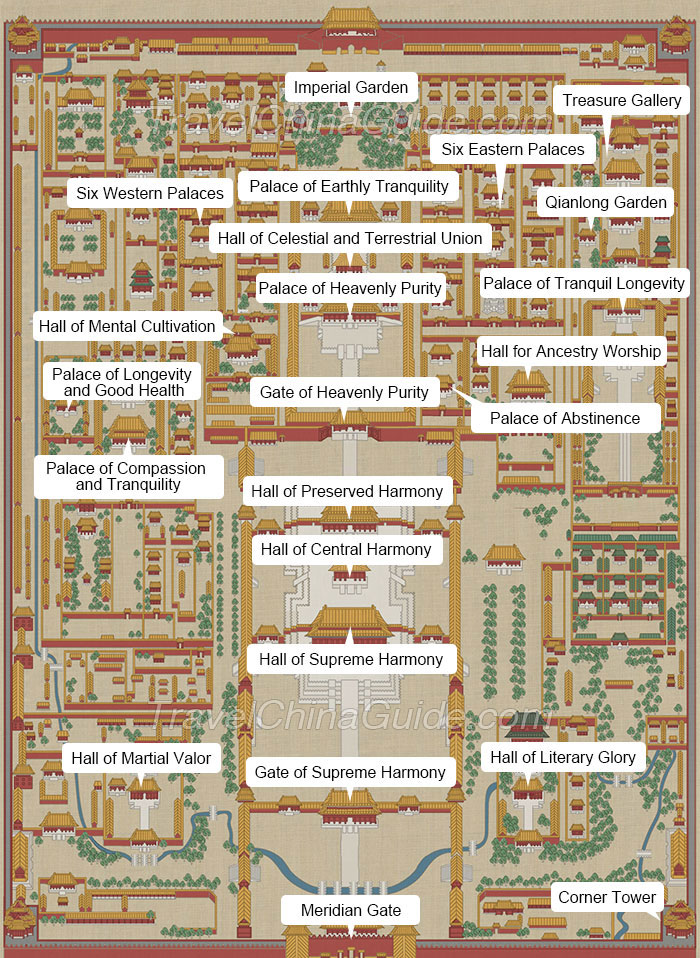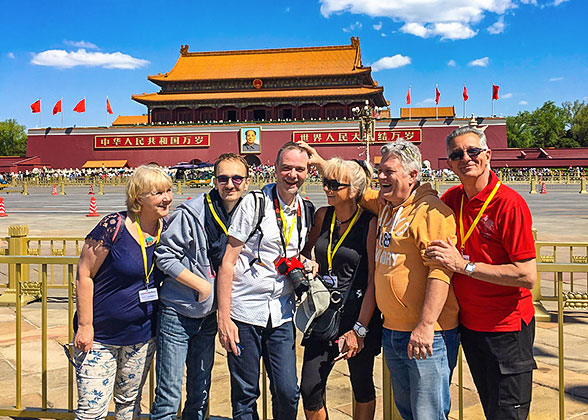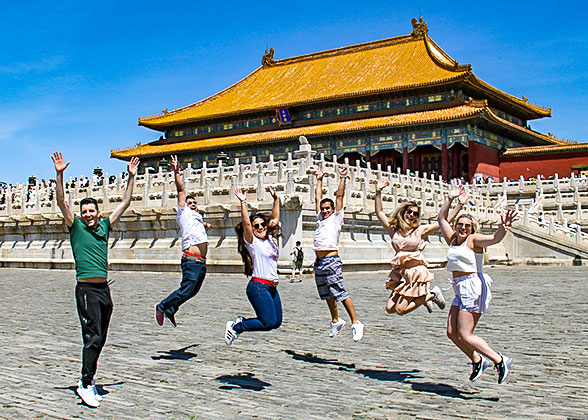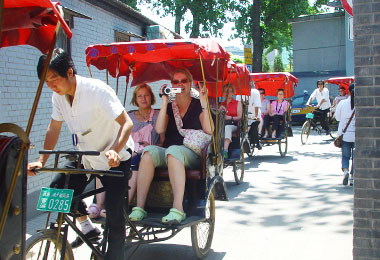Forbidden City (Palace Museum)
English Names: Forbidden City / Palace Museum
Location: very center Beijing, China
Area: 72 hectares
Construction Time: 1406 to 1420, Ming Dynasty
Initiator: Emperor Chengzu of the Ming Dynasty
Designer: Kuai Xiang
Previous Residents: 14 emperors from the Ming Dynasty (1368 - 1644), 10 emperors from the Qing Dynasty (1644 -1911), and their royal families.
8 Fun Facts about Forbidden City
Forbidden City History – Timeline from 1406
Who built the Forbidden City?
When was it built?
Why was it built?
Why is it called the Forbidden City?
Top 20 Forbidden City FAQs
The Forbidden City, also known as the Palace Museum, lies in the city center of Beijing, and was once the Chinese imperial palace of the Ming and Qing Dynasties (1368 - 1911). It was listed as a World Heritage Site in 1987 and is the largest, best-preserved ancient timber-built palace complex in the world.
Constructed between 1406 and 1420 during the reign of Emperor Chengzu of the Ming Dynasty (1368-1644), the Forbidden City was home to 24 emperors and their families and acted as the ceremonial and political center of ancient Chinese government throughout 500 years. After the Last Emperor of China left the palace, it later became a museum open to the public in 1925. Since then, the Forbidden City is no longer ‘forbidden’, and now ordinary people are able to take a virtual trip in time to see the secrets and luxury of imperial life.
Rectangular in shape, the Forbidden City is enormous, covering an area of 72 hectares, and boasting more than 9,000 bays of rooms. It is divided into two parts – the Outer Court for national affairs in the south and the Inner Court as living quarters in the north. It is not only an immense architectural masterpiece, but also a treasury housing a unique collection of 1.8 million pieces of art, including ancient calligraphy and painting, imperial artifacts, ancient books and archives. A must-see in Beijing and the world’s most visited museum, it is worth spending half to one day to visit the Forbidden City and appreciate the precious cultural heritage of China.
How to Tour the Forbidden City
Where to Eat - Restaurants in the Forbidden City
Layout and Major Palaces
• Length (north-south): 961 meters (1,051 yards)
• Width (west-east): 753 meters (823 yards)
• Total Area: 72 hectares (178 acres)
• Building Area: 15 hectares (37 acres)
Located to the north of the Tiananmen Square, the rectangular Forbidden City is enclosed by a 10 meters (33 feet) high outer wall and surrounded by a 52 meters (57 yards) wide moat. It has four gates: the Meridian Gate (Wumen) in the south, the Gate of Divine Prowess (Shenwumen) in the north, the West Prosperity Gate (Xihuamen) and the East Prosperity Gate (Donghuamen). On each of the four corners of the outer wall, there is a delicately structured corner tower.
Standing on the wall or the towers, or seeking a higher viewpoint from the Jingshan Mountain to the north of the Forbidden City, you can get the feel of the truly massive scale of the palace complex. For comparison, the Forbidden City is four times the size of the Taj Mahal of India (18 hectares), which is mainly composed of gardens. Here the Forbidden City, with a multitude of palaces, has a building area even larger than that of the Palace of Versailles in France (11 hectares).
The high outer walls enclose a labyrinth of more than 90 palaces and courtyards, with over 9,000 bays of rooms! The layout is in perfect symmetry, with the north-south central axis ingeniously designed for not only the forbidden palace complex, but also the whole of today’s Beijing city. The major palaces extend along the axis, while the minor halls stand on the west and east sides, all being well arranged in five north-south lines: Central Axis, West Wing, East Wing, Outer West Route, and Outer East Route.
 |
| Forbidden City Overview |
For different functions, the complex is divided into the Outer Court in the south and the Inner Court in the north.
The Outer Court was used for state ceremonials, with three main halls on the central axis, namely the Hall of Supreme Harmony (Taihedian), the Hall of Central Harmony (Zhonghedian), and the Hall of Preserved Harmony (Baohedian), and two wing structures – the Hall of Martial Valor (Wuyingdian) in the west, and the Hall of Literary Glory (Wenhuadian) in the east.
The Inner Court was the residential area, including the three central palaces for the emperor and the empress, namely the Palace of Heavenly Purity (Qianqinggong), the Hall of Celestial and Terrestrial Union (Jiaotaidian), and the Palace of Earthly Tranquility (Kunninggong), which are flanked by Six Western Palaces and Six Eastern Palaces for concubines and maids of different ranks. There is an Imperial Garden at northernmost part, affording views and entertainments.
 |
| Palace of Heavenly Purity, the Emperor's Living Quarter |
Layout of Forbidden City – Outer Court and Inner Court in Perfect Axisymmetry
How big is the Forbidden City?
How Many Rooms are there in the Forbidden City? 9999.5?
 |
| Major Palaces along Central Axis |
Follow the Experts to Explore the Essence of Forbidden City
Epic of Ancient Chinese Architecture
600 Years’ History
Imperial Life and Anecdotes
Top-Level Exhibitions
Cultural Souvenirs Frenzy
The core value of the Forbidden City lies in its architecture.
The largest wooden palace complex with more than 9,000 rooms makes you believe that it truly was once the center of the world. The layout of the buildings is in harmony and symmetry along the central axis, with huge squares and majestic ceremonial palaces in the Outer Court, while quiet yards and delicate living chambers in the Inner Court. The red walls, golden roofs and exquisite decorations evoke a sense of breathtaking antiquity.Unveil 600 Years’ Historical Myths of Forbidden City
In 1406, Emperor Chengzu of the Ming Dynasty ordered the building of the Forbidden City in Beijing based on the Imperial Palace in Nanjing, the Ming capital at that time. With 11 years’ preparation, the construction took three years from 1417 to 1420. After its completion, the emperor moved the capital to Beijing, and the Forbidden City began its history as the supreme power center of Ming and Qing Dynasties.What was life like in the Forbidden City?
From the founder of the palace Emperor Zhu Di of the Ming Dynasty, to Puyi, the Last Emperor of the Qing Dynasty, the Forbidden City served as the state residence for 24 emperors and their families. Throughout hundreds of years, the political battles among ministers and harem fights in the Inner Court set the palace awash with victims of power struggles, leaving many stories and mysteries, and even some supernatural tales.It is home to over 1.8 million pieces of art.
Known as Palace Museum, the Forbidden City houses an extensive collection of priceless artworks in some of the palaces, together with two special exhibitions, namely the Treasure Gallery and the Gallery of Timepieces. Most of the exhibits are ancient artifacts from the Ming and Qing courts, including paintings and calligraphy, sculptures, porcelain, gold and silver ware, jade, bronze ware, embroidery, wooden furniture, clocks and watches, religious instruments, jewelry, books and archives.Cultural and Creative Pioneer
The 600-year-old Forbidden City has become a web celebrity due to its ingenious cultural products. From miniatures of the imperial residences to various household items decorated with the palace elements including folding fans, earphones, handbags, baggage tags, and lipsticks, the souvenirs with cultural interests and creative designs are popular among tourists especially the young. The museum's yearly revenue from the cultural products reaches CNY 1.5 billion.
How to Get to the Forbidden City
Entry is allowed only through the Meridian Gate, the south gate of the museum.
 |
| Meridian Gate |
Take subway line 1, get off at Tiananmen East Station (Exit B) or Tiananmen West Station (Exit B), walk 500 meters (550 yards) to the Tiananmen Tower, and then walk north to the Meridian Gate.
2. Bus:
Take bus line 1, 2, 52, 82, 120, Sightseeing Bus Line 1 or 2, and get off at Tiananmen East Station; or take bus line 1, 5, 52, Sightseeing Bus Line 1 or 2, and get off at Tiananmen West Station.
How to Get to Forbidden City and Tiananmen Square
How to Get from Beijing South Railway Station to Forbidden City & Tiananmen Square
Beijing Bus / Subway Search
How to Leave the Forbidden City
Exit is allowed through the northern Gate of Divine Prowess, and the East Prosperity Gate.
|
|
Upon exiting the Gate of Divine Prowess, take buses 58, 101, 103, 109, 124, 128, or Sightseeing Bus Lines 1 or 2 from the Gate of Divine Prowess Station, or buses 58, 111 or 124 from Jingshan East Gate Station. If time permits, consider climbing Jingshan Mountain opposite the gate, to enjoy a panoramic view of the Forbidden City.
From the East Prosperity Gate, take Sightseeing Bus Line 2 from Gugong East Gate Station or bus line 2 or 82 from Donghuamen Station. Before leaving, Before leaving, take a leisurely 800-meter (875-yard) walk to the east Wangfujing Street for shopping and dining pleasures.
How to Buy Forbidden City Tickets
|
|
2. All visitors need to buy e-tickets online beforehand, through the official website of the museum (English Version), its WeChat mini program (no English version) or travel agencies offering English service.
3. The tickets are released 7 days in advance from 20:00 to 21:00 by the authority, but buy as early as possible for the tickets are in great demand always. Ask for help from a travel agency if you expect ticketting not to upset your schedule.
4. Passports of foreigners or ID cards of visitors from Mainland China, Hong Kong, Macau and Taiwan are needed when buying tickets. Each individual is limited to one ticket for one day.
5. Show your passport or ID card at the entrance, and there is no need to get the paper tickets.
| Entrance Ticket Price | April to October: CNY 60 November to March: CNY 40 |
| Treasure Gallery | CNY 10 (in the Palace of Tranquil Longevity, including the Opera Museum and Stone Drum Museum) |
| Gallery of Timepieces | CNY 10 (in the Hall for Ancestry Worship) |
1. Free admission for children 6 years old or younger and children under 1.2 meters (3.9 feet) in height.
2. For minors between 7 and 18 years old, the admission ticket price is CNY 20 and the ticket for Treasure Gallery and Gallery of Timepieces each is CNY 5.
3. Seniors older than 60 can enjoy half price for both the entrance tickets and the tickets for the two galleries.
4. If you plan to enter the Forbidden City through Tiananmen Square, please ensure that you have made a prior reservation for Tiananmen Square.
Opening Hours
| Months | Opening Hours | Ticketing Time | Entry Time |
| April to October | 8:30-17:00 | 8:30-16:00 | 8:30-16:10 |
| November to March | 8:30-16:30 | 8:30-15:30 | 8:30-15:40 |
Recommended Guided Tours
You May Like
Why is the Forbidden City Important?
Top 10 Things to Do in Beijing
Top 10 China Tourist Places for Culture Lovers
Top 10 China Tourist Attractions List









